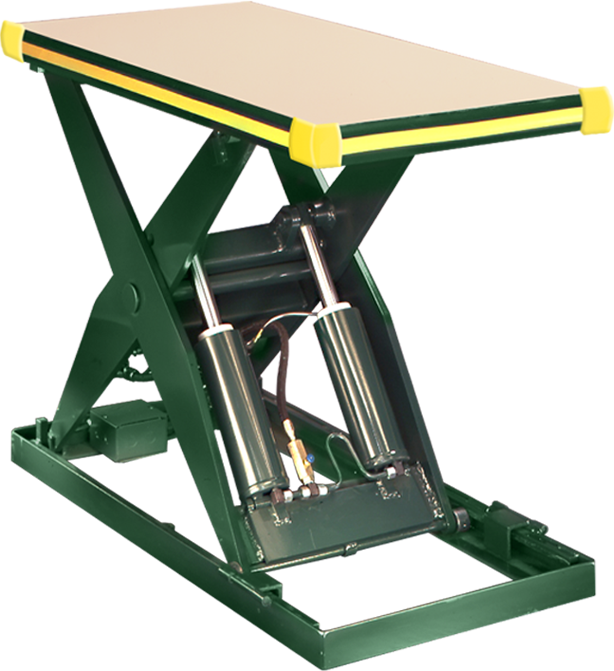
Understanding How Hydraulic Lift Tables Work : A Material Handling Guide
Introduction:
In many industrial settings, hydraulic lift tables play a crucial role in facilitating material handling, assembly, and ergonomic operations. Hydraulic lift tables are versatile and efficient tools used in various industries for lifting and positioning heavy loads. Whether in warehouses, manufacturing facilities, or workshops, these devices play a crucial role in improving productivity and ensuring worker safety. These versatile pieces of equipment offer a reliable and efficient solution for lifting heavy loads and positioning them at various heights. In this blog, we will explore the inner workings of hydraulic lift tables, understand their components, and delve into the process of how they operate.
Section 1: The Components of a Hydraulic Lift Table
Hydraulic Cylinder: At the heart of the hydraulic lift table is the hydraulic cylinder. This component converts hydraulic pressure into mechanical force, allowing the table to move up or down smoothly.
Hydraulic Pump: The hydraulic pump is responsible for generating the hydraulic pressure needed to operate the lift table. It draws fluid from a reservoir and pressurizes it, providing the force required for lifting.
Control Valve: The control valve regulates the flow of hydraulic fluid, allowing for precise control over the lifting and lowering movements. It provides operators with the ability to adjust the speed and direction of the lift table.
Power Unit: The power unit houses the hydraulic pump, motor, reservoir, and control components. It is responsible for supplying power and control signals to the lift table.
Section 2: Understanding the Working Mechanism
Lifting Phase: When the lift table is at its starting position, the hydraulic pump starts operating, creating pressure within the system. The control valve opens, allowing hydraulic fluid to enter the cylinder, extending the piston rod and lifting the table platform.
Holding Phase: Once the desired height is reached, the control valve closes, preventing further fluid flow into the cylinder. At this point, the hydraulic pressure is trapped within the cylinder, maintaining the lift table in its raised position.
Lowering Phase: When it's time to lower the hydraulic lift table, the control valve will open in the opposite direction, allowing hydraulic fluid to exit the cylinder. As the fluid is released, the weight of the load and gravity assist in the downward movement of the platform.
Section 3: Advantages of Hydraulic Lift Table
Heavy Load Capacity: Hydraulic lift tables are capable of lifting and supporting heavy loads, making them suitable for a wide range of industrial applications.
Precise Positioning: The hydraulic system allows for precise control over the lifting and lowering movements, enabling operators to position loads accurately.
Smooth and Quiet Operation: Hydraulic lift tables offer smooth and quiet operation, minimizing noise pollution in the workplace.
Safety Features: Many hydraulic lift tables are equipped with safety features such as safety rails, interlocking systems, and overload protection, ensuring operator safety during operation.
Section 4: Applications of Hydraulic Lift Table
Material Handling: Lift tables are commonly used for lifting and positioning heavy materials and equipment in warehouses, factories, and distribution centers. They can assist with loading and unloading trucks, stacking pallets, and transferring materials between different workstations.
Assembly Operations: Material handling lift tables provide ergonomic solutions for assembly processes, allowing workers to position work pieces at comfortable heights for efficient assembly and reducing strain on their bodies. They are often used in industries such as automotive, electronics, and appliance manufacturing.
Ergonomics and Workplace Safety: hydraulic Lift tables promote proper ergonomics by eliminating the need for workers to bend, stoop, or reach excessively. By positioning loads at an optimal height, lift tables reduce the risk of workplace injuries such as strains, sprains, and musculoskeletal disorders.
Maintenance and Repair: Lift tables are valuable in maintenance and repair tasks, providing a stable and adjustable platform for technicians to work on heavy machinery, equipment, or vehicles. They can also facilitate easy access to elevated areas for maintenance and inspection purposes.
Packaging and Shipping: Material handling lift tables for pallets are useful in packaging and shipping operations, where they assist in the loading and unloading of boxes, containers, and crates onto pallets or trucks. They ensure efficient handling of goods, preventing damage during transportation.
Retail and E-commerce: hydraulic lift tables play a role in retail and e-commerce environments by facilitating inventory management, order picking, and stock replenishment. They enable workers to efficiently organize and access merchandise, optimizing storage space and order fulfillment processes.
Scissor Lift Applications: Pallet scissor lift table, a type of lift table, are commonly used in construction, maintenance, and event industries. They provide vertical access for working at heights, allowing workers to perform tasks such as installation, painting, maintenance, and stage setup.
Vehicle Loading: Material handling lift tables are utilized for loading and unloading vehicles, particularly in industries such as logistics, transportation, and warehousing. They can be integrated into loading docks or used as standalone units to facilitate efficient and safe loading operations.
Industrial Equipment Positioning: Lift tables are used to position heavy industrial equipment and machinery during installation, maintenance, and repair. They provide stability and precision in aligning equipment components or adjusting their heights for specific operations.
Conclusion:
Hydraulic lift tables are an essential asset in various industries, providing efficient and reliable lifting solutions for heavy loads. Understanding the working mechanism and components of hydraulic lift tables enables operators to make the most of this equipment while ensuring safe and productive operations. With their versatility and robust design, hydraulic lift tables continue to play a vital role in enhancing material handling processes in warehouses, manufacturing facilities, and other industrial environments.



